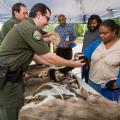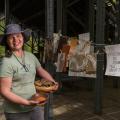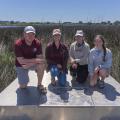Attracting Butterflies to Mississippi Gardens
Butterflies provide a beautiful living element in the landscape. In addition to their myriad colors, sizes, and forms, they provide an important role of pollinating many wildflowers and woody plants. The key to attracting butterflies is to simply provide their food sources and other living needs, both for adults and caterpillars. While providing for these needs, beautiful flowering gardens are often created as well.
Certain butterfly species are specific to particular environments, ranging from deep shady woods to open sunny meadows and dunes. Each type selects a particular place according to a certain geographic elevation, latitude, available plant species, lack of predators, and other factors. In other words, the more variety of habitats and plants that you provide on your property, the more species of butterflies will occur.
The Butterfly Life Cycle
Though we most often enjoy and appreciate the winged adults, understanding the butterfly life cycle is important when encouraging butterflies. A butterfly's life begins as an egg that is laid on a particular host plant. Usually, the eggs are laid on the bottoms of the leaves and can vary widely in shape, form, size, and color. Within two weeks the tiny eggs hatch, and tiny caterpillars emerge. The larva consumes the host plant's leaves and will shed its skin several times as it grows. Get a caterpillar identification guide if you are concerned about which ones are harmful or helpful. In about a month, the larva is ready to form a chrysalis (pupa). After a few weeks, the magical transformation takes place and an adult butterfly is born. Most adult butterflies live for only a short time–some species must mate and live for just a few days–and others are known to last over a year.
The Butterfly Garden
A successful garden for attracting butterflies accommodates for their food, shelter, and breeding needs. Since butterflies are cold-blooded, they require sunny areas in order to warm up and move around. At night they hide under the cover of leaves of shrubs and trees, and thus need vegetated areas as well. Unless these needs are provided for in your neighborhood you will see few butterflies in your backyard. Avoid the use of pesticides in the garden.
Food
Butterfly food falls under two categories: host plants and nectar plants, both of which are necessary to continue populations. Host plants are specific plants that the eggs are laid on and that the caterpillars eat. Nectar plants are the flowering plants that the adult butterflies feed upon. The following is a list of both host and nectar plants that successfully grow in Mississippi.
HOST PLANTS
Common name |
Scientific name |
Butterfly types |
|
||
|
Aster |
Aster spp. |
Pearl crescent |
|
||
|
Blueberry |
Vaccinium spp. |
Brown elfin |
|
||
|
Cottonwood |
Populus spp. |
Admirals, red-spotted |
NECTAR PLANTS
Common name |
Scientific name |
Flowering time |
|
||
|
Clover |
Trifolium |
Spring |
|
||
|
Rhododendron |
Rhododendron spp. |
Spring |
|
||
|
Buckeye |
Aesculus spp. |
Spring |
Shelter
These winged insects need shelter from the wind and rain, as well as a roosting place for the night. Shrub foliage is often used for protection, as well as sleeping quarters. You can create a butterfly shelter area by constructing a simple log pile in a corner of the back yard. Simply stack cut logs anywhere from 3 to 5 feet high and from 3 to 5 feet long. Be careful though, as this provides butterfly shelter it will also provide shelter for other wildlife as well.
Mud Puddles
Mud puddles are the way that some butterflies obtain additional water and minerals. Sulphurs, swallowtails, skippers, and blues will visit these wet areas. Simply provide a wet muddy area in the garden, or provide a man-made stream or pond where water can splash.
Rocks
A few flat stones placed in open sunny areas of the garden gives butterflies an area to warm up on cool mornings. They will also use brick or concrete patios, walkways, or decks for basking.
These factsheets were written by Robert F. Brzuszek, Assistant Extension Professor, The Department of Landscape Architecture, Mississippi State University.
Publications
News
An underserved community spent a day enjoying the outdoors at the Sam D. Hamilton Noxubee National Wildlife Refuge in early May as Mississippi State University Extension Service personnel hosted 20 adult residents of care homes.
Jim McAdory, MSU Extension agent in Winston County, coordinated the May 1 event with help from several other Extension agents and U.S. Fish and Wildlife Service staff. The goal was to allow this population to experience the outdoors, complete with a hot dog lunch at the end of the event.
PICAYUNE, Miss. -- School groups, nature enthusiasts and the public can enjoy two fun-filled days of exciting, hands-on learning about the environment, ecosystems, wildlife and insects at the Mississippi State University Crosby Arboretum in Picayune. BugFest offers insect-related displays, interactive exhibits, games and crafts. Biologists, naturalists, entomologists and other experts from Mississippi, Louisiana and Alabama will host booths and give presentations on butterflies, bats, caterpillars, beetles, crayfish, ladybugs, hissing cockroaches, dancing praying mantises, native and exotic arthropods and more.
Two conservation camps this summer offer students in grades six through 12 the opportunity to gain hands-on experience in wildlife science, outdoor recreation and conservation careers. Conservation Camp 2022 has a residential edition June 5-8 for rising eighth through 12th graders. The day camp edition is June 13-15 for rising sixth through eighth graders.
Success Stories
More than 80 grade-school students from Choctaw Tribal Schools visited Mississippi State University in March to participate in Choctaw Preview Day.
Robin Whitfield, who gave the child the paper, stands awestruck, watching her friend’s daughter use the flower to draw and color on the page.
Mississippi State University and partners have been awarded a grant of nearly $6.6 million from the National Fish and Wildlife Federation for shoreline restoration work on the Gulf Coast.





